GODOX PHOTO EQUIPMENT TT350 Thinklite TTL Camera Flash User Manual 2
GODOX PHOTO EQUIPMENT CO.LTD Thinklite TTL Camera Flash 2
Users Manual
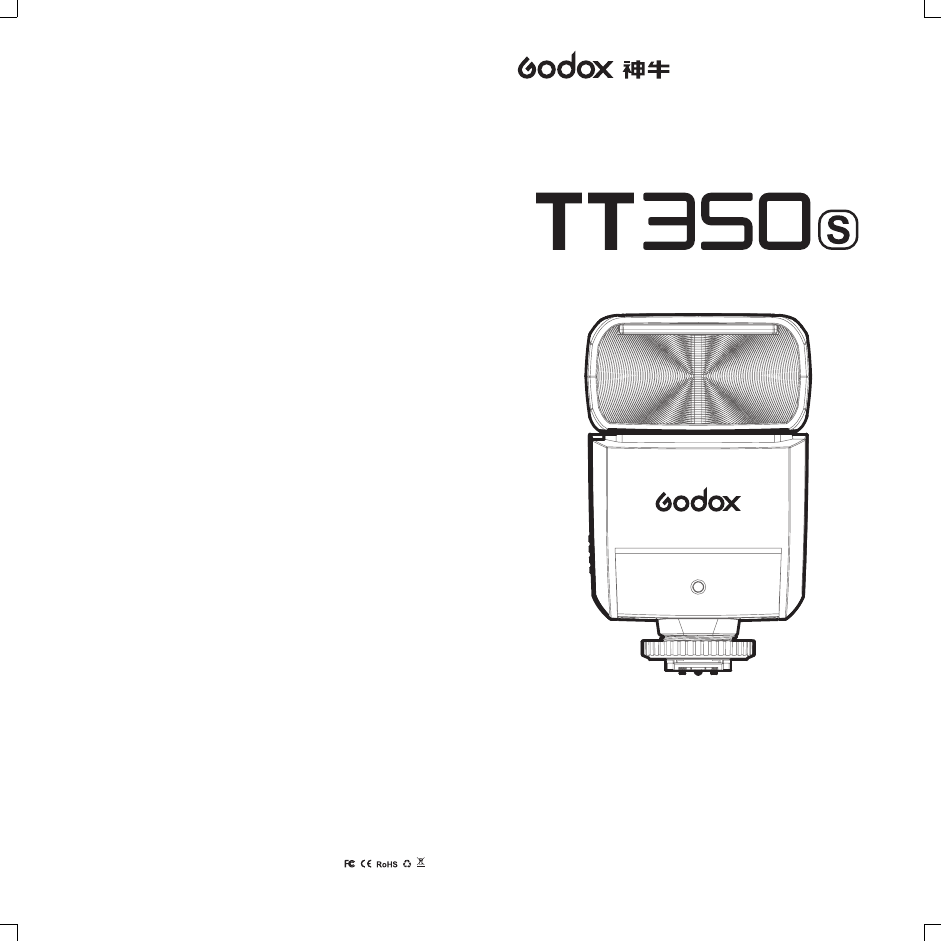
迅丽TTL机顶闪光灯
Thinklite TTL Camera Flash
INSTRUCTION MANUAL
说 明 手 册
中英文双语 / Chinese English Bilingual
在使用本产品之前:
请先仔细阅读本手册,以确保您能安全使用。请保存好本手册以备将
来查询参考。
For Sony
Before using this product:
Please read this user manual carefully in order to ensure your safety
and the proper operation of this product. Keep for future reference.
705-TT35S0-00
地址/Add: 深圳市宝安区福永镇福洲大道西新和村华发工业园A4栋
Building A4, Xinhe Huafa Industrial Zone, Fuzhou RD West, Fuyong
Town, Baoan District, Shenzhen 518103, China
电话/Tel: +86-755-29609320(8062) 传真/Fax: +86-755-25723423
邮箱/E-mail: godox@godox.com
http://www.godox.com
神牛摄影器材有限公司
GODOX Photo Equipment Co., Ltd.
Made In China

请勿让本产品淋雨或受潮,以免发生火灾或触电。
本产品内部有高压元件,切勿自行拆解或维修。如果接触产品内
部的高压电路,可能会发生触电。需要修理时,请送往指定地点
进行专业维修。
在使用过程中,如果本产品由于跌落、受到挤压或遭受强烈冲击
而造成外壳破裂的,请勿继续使用,以免因接触到内部电子元件
而受到电击伤害。
请勿在近距离将闪光灯头正对人眼闪光(特别是婴儿的眼睛),
否则可能会在短时间内造成视力障碍。在使用闪光灯拍摄婴儿
时,建议闪光灯距离婴儿至少1米以上,也可以使用反射闪光来
减少闪光可能对视力造成的伤害。
请勿在化学品、可燃性气体或其他特殊物质附近使用闪光灯,这
些物质在特殊情况下可能对闪光灯发出的瞬间强光敏感,有可能
导致火灾或电磁干扰。在这些场合下,请注意相关警告标识。
请勿将本产品放置在超过50摄氏度的环境下,否则可能对元器件
造成损坏。
本产品不能防水,在雨天及潮湿环境下请注意防水。
在使用本产品之前:
请先仔细阅读本手册,以确保您能安全使用。请保存好本手册以
备将来查询参考。
感谢您购买神牛产品。
该型号机顶闪光灯适用于SONY系列相机,兼容TTL 自动闪光。
使用TTL闪光灯,您将获得更简单的拍摄体验,在光线变化复杂的情
况下,可以自动获得准确的闪光曝光,拍摄轻松自如。产品特点突出
表现在以下几方面:
● GN36 (m ISO 100, @105mm)
● 兼容索尼相机TTL
支持TTL自动闪光,可作为无线多灯闪光系统的主控或从属单
元,拍摄更简单快捷。
● 高清液晶屏
显示直观,操作更加简易
● 内置2.4G无线传输
收发一体,超远距离,创意无限
● 功能齐全,无限享用
支持手动和频闪闪光模式,高速同步/第二帘快门同步/闪光曝
光补偿等功能
● 固件升级,兼容无忧
跟随原厂相机步伐,可对软件进行再升级
安全须知
前言
- 01 - - 02 -

前言
安全须知
部件名称
机身
控制面板
液晶显示屏
标配物品
可选购附件
装卸闪光灯
电源管理
闪光模式:TTL自动闪光模式
闪光曝光补偿
高速同步
第二帘快门同步
闪光模式:M手动闪光
闪光模式:Multi频闪闪光
无线闪光拍摄:无线电(2.4G)传输
无线设置
设置主控闪光灯的闪光模式
设置通讯频道
TTL:全自动无线闪光拍摄
M:⼿动无线闪光拍摄
Multi:手动无线闪光拍摄
其他应用
自动辅助对焦灯
反射闪光
创建眼神光
ZOOM:设置闪光覆盖范围并使用广角散光板
电池电量低警示
C.Fn: 设置自定义功能
保护功能
固件升级
规格参数
故障排除指南
兼容相机列表
维护保养
目录
本说明书中使用的约定
● 此使用说明书中的操作步骤假定相机和闪光灯的电源开关已开启。
● 参考页码由(第**页)表示。
● 此使用说明书中使用以下警告符号:
该“小心”符号表示避免出现拍摄问题的警告。
该“注意”符号提供补充信息。
迅丽TTL机顶闪光灯
Thinklite TTL Camera Flash
E l e c t r o n i c C a m e r a F l a s h
01
02
05
07
07
08
09
10
11
16
19
19
20
21
22
23
23
- 03 - - 04 -
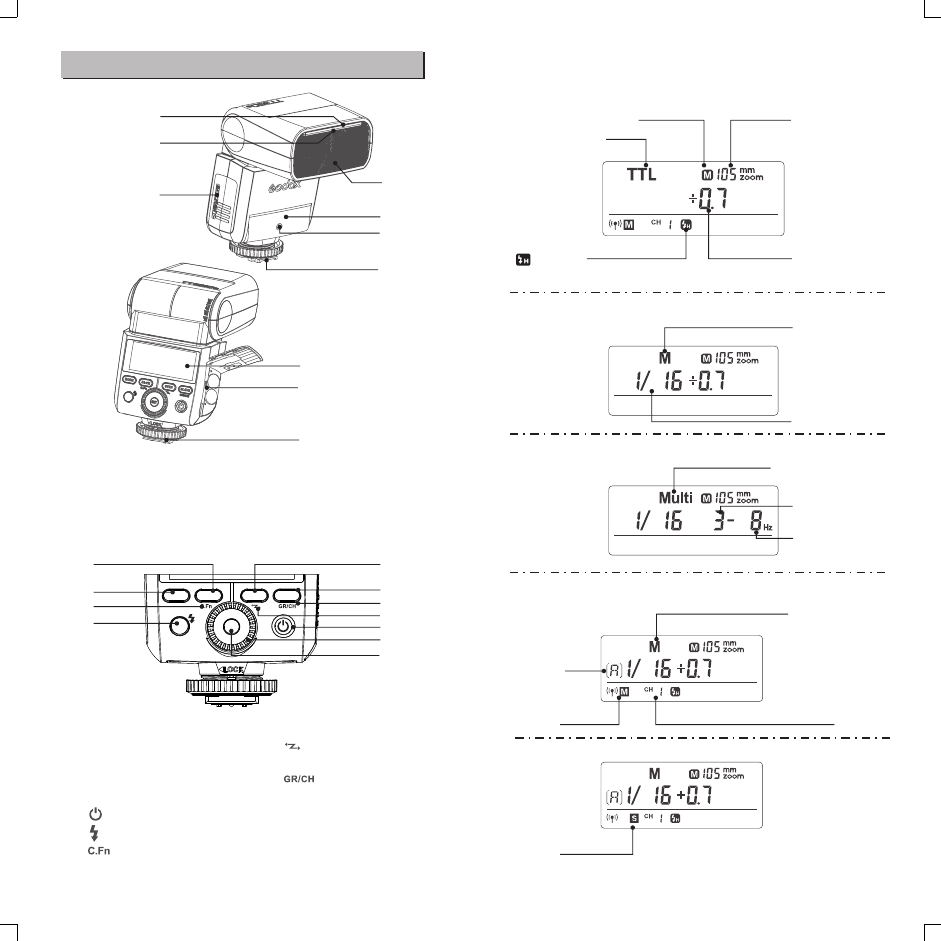
MODE ZOOM SYNC SLAVE
SET
01. 眼神光板
02. 内置广角散光板
03. 闪光灯头
04. 光控传感器
05. 辅助对焦灯
06. 热靴
07. 液晶显示屏
08. 固定旋钮
09. 电池仓
10. USB端口
● 机身
11. <MODE>闪光模式选择按钮
12. <ZOOM>ZOOM选择按钮
13. <SYNC>高速同步按钮
14. <SLAVE>S1/S2光控选择
(在非无线模式)
15. < >电源按钮
16. < >试闪按钮/回电指示灯
17. < >自定义按钮
(复用按钮,长按2秒)
18. < >无线按钮
(复用按钮,长按2秒)
19. < >组别/频道按钮
(复用按钮,在无线模式)
20. 调节旋钮
21. <SET>设置按钮
● 控制面板
12 13
11
16
21
20
15
● 液晶显示屏
部件名称
02
14
(1) TTL自动闪光
Zoom : 变焦显示(第18页)
TTL : TTL自动闪光
焦距(闪光覆盖/第18页)
: 高速同步
(第09页)
闪光曝光补偿量
(2)M手动闪光
M : 手动闪光
手动闪光输出
(3)Multi频闪闪光
Multi : 多重(频闪)闪光
闪光次数
闪光频率
01
03
04
05
06
07
08
09
10
17 18
19
- 05 - - 06 -
闪光模式
频道
(4)无线电传输拍摄
● 主控单元
闪光组
● 从属单元
主控
从属
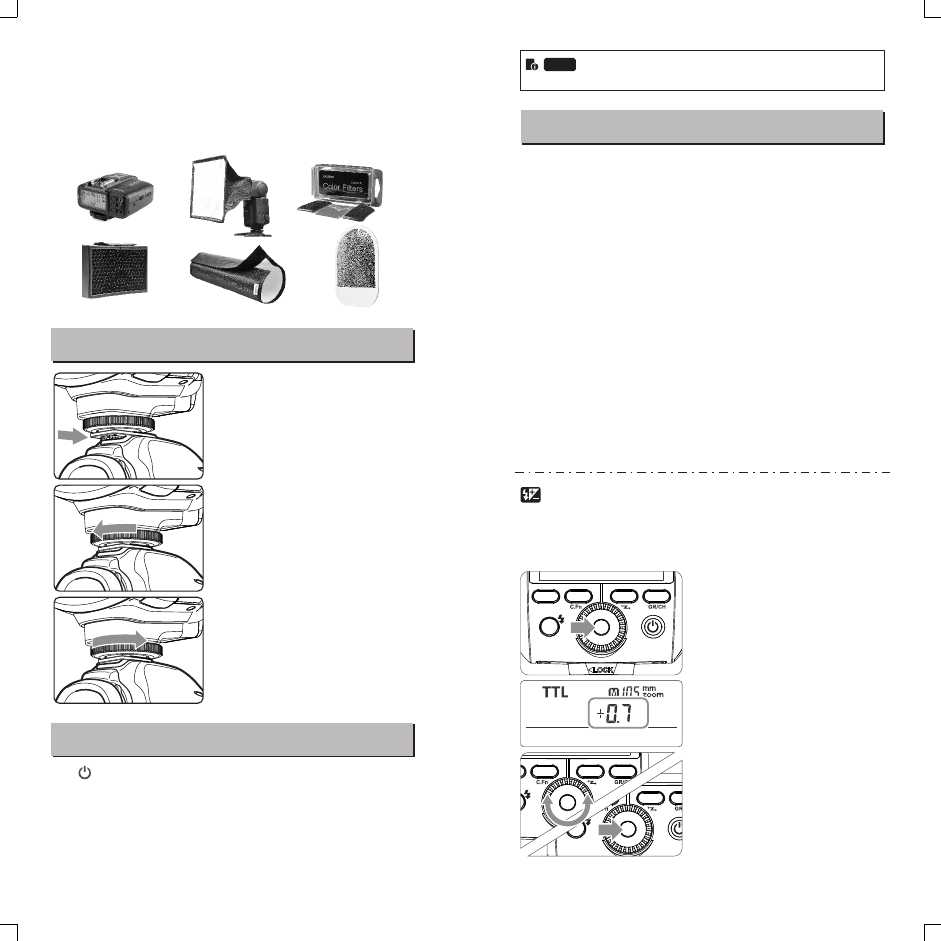
ZOOM SYNC SLAVE
SET
● 可选购附件
可搭配本公司以下摄影附件使用,以获得最佳的拍摄效果和使用体验:
X1T-S无线引闪器、迷你柔光箱、反光板、蜂巢、色片、束光布等。
● 标配物品
1、灯体 2、微型底座 3、保护包 4、柔光罩 5、说明书
装卸闪光灯
安装闪光灯。
1● 滑动闪光灯固定座使其完
全插入相机的热靴插座。
拧紧闪光灯。
2● 旋转固定座上的锁定旋
钮,直到锁定闪光灯。
取下闪光灯。
3 ● 旋转固定座上的锁定旋
钮,直到闪光灯解除锁定。
电源管理
使用 电源开关控制该产品的打开(长按1秒)和关闭,长时间不使用
时请关闭电源。本产品设计有电源自动关闭功能。作为主控单元在长
时间(约90秒)无人操作时,闪光灯会自动关闭,半按快门按钮或机
身任意键唤醒;作为从属单元(S1/S2、无线SLAVE)在60分钟无任
何操作时,闪光灯会进入休眠状态,此时可按机身任意键唤醒。进入
休眠状态60分钟后自动关机。
离机使用时,建议通过自定义功能使“自动关闭电源”无效。
(C.Fn-ST 第19页)
C.Fn
- 07 -
MODE ZOOM SYNC SLAVE
SET
闪光模式:TTL自动闪光模式
该闪光灯有TTL自动闪光,M手动闪光,Multi频闪闪光三种模式。
在TTL模式下,相机的测光系统会侦查从主体反射回来的闪光照明,
从而自动调节闪光输出量,使主体和背景得到均衡曝光。支持曝光补
偿、高速同步、第二帘快门同步等功能。
*按下<MODE>模式选择按钮,三种闪光模式将会依次出现在液晶
屏上。
TTL模式
通过按<MODE>模式选择按钮,将闪光灯设置为<TTL>, 可以使闪
光灯进入TTL模式。
● 半按相机快门按钮进行对焦
● 在快门释放前的瞬间进行一次预闪,闪光灯接收相机信息进行主闪
光。
“HI”提示:当闪光功率达到最大值时,会显示“HI”闪烁3秒。
如果此时欠爆请调整相机的参数;
“Lo”提示:当闪光功率达到最小值时,会显示“Lo”闪烁3秒。
如果此时过爆请调整相机的参数。
闪光曝光补偿
该闪光灯可以在±3档间以1/3档为增量调节闪光曝光补偿。由于环境
的需求而需要微调TTL系统时,这个功能非常有用。
设置闪光曝光补偿:
按下SET按键,进入调整状
1态,此时补偿量闪烁。
转动调节旋钮设置曝光补偿
2量。
● “0.3”表示1/3档,
“0.7”表示2/3档。
● 要取消闪光曝光补偿,
将闪光曝光补偿量设为
“0”。
MODE ZOOM SYNC SLAVE
SET
按下< SET >设置按钮,确
3定闪光曝光补偿。
- 08 -

MODE ZOOM SYNC SLAVE
SET
MODE ZOOM SYNC SLAVE
SET
● 在SONY相机机身设置中,选择 Rear闪光方式。
第二帘快门同步
使用慢速快门,您可以在被摄物体后创建一条光线轨迹。在快门关闭
前的瞬间闪光灯闪光。
高速同步
使用高速同步(HSS闪光),您可以在所有的快门速度下同步使用闪光
灯。高速同步模式下,使用光圈优先对人像进行填充闪光时特别方
便。按<SYNC>按钮可开启高速同步闪光,此时高速符号< >显
示,然后调节SONY相机快门可实现高速同步闪光。
● 使用高速同步,快门速度越高,有效的闪光范围就越小。
● 在高速同步模式下,无法设置频闪闪光。
● 连续高速同步闪光15次后,闪光灯热保护功能可能会被激活。
● 尽量不使用高速同步闪光,因为高速同步闪光会缩短闪光管寿命。
- 09 - - 10 -
您可以在1/128功率至1/1全功率间以1/3档为增量设置闪光输出。为
获得正确的闪光曝光,请使用手持的闪光测光表确定所需的闪光输出。
按<MODE>模式选择按钮,
1屏幕显示<M>。
转动调节旋钮设置闪光输出
2功率。
显示闪光输出
拍摄过程中更改闪光输出时,下表将清楚地显示光圈值是如何更改
的,如1/2-0.3→1/2+0.3。您可以在增加或减少闪光输出时查看光圈
值的更改规律。
例如,将闪光输出量减少至1/2、1/2-0.3或1/2-0.7,然后再将其增
加至大于1/2、1/2+0.3、1/2+0.7时,将显示1/1。
闪光模式:M 手动闪光
在 高速同步模式,可调闪光
范围1/16~1/1。
减少闪光输出指数→
←增加闪光输出指数
1/41/21/1 1/1–0.3
1/2+0.7
1/1-0.7
1/2+0.3
1/2-0.3
1/4+0.7
1/2-0.7
1/4+0.3
······
······
在M模式下,可以实现 高速同步和第二帘快门同步功能(第09页)。
S2光控单元设置
在M手动闪光模式下,按<SLAVE>可以使用S2功能,闪光灯可作为
副灯使用,适用于TTL闪光环境。具有防预闪功能,使用带一次预闪
功能的相机能用光控实现同步拍摄。它会与主闪光灯的第二次闪光同
步触发闪光,即2次光控引闪。
S1光控单元设置
在M手动闪光模式下,按<SLAVE>可以使用S1功能,闪光灯可作为
副灯使用,创造多种照明效果,适用于手动闪光环境。它会与主闪光
灯的第一次闪光同步触发闪光,效果与使用无线引闪器一致。
● 只有在M模式下才支持S1/S2光控引闪模式。
闪光模式:Multi 频闪闪光
使用频闪闪光,可以发出一系列快速的闪光。它可以在一张照片上拍
摄移动物体的多个图像。您可以设置闪光频率(每秒的闪光次数,以
Hz表示)、闪光次数和闪光输出。
按<MODE>闪光模式选择按
1钮,屏幕显示<Multi>。
设置闪光频率和闪光次数。
3● 按SET按钮选择闪光频率,
旋转调节旋钮设定数字。
● 再按SET按钮选择闪光次
数,旋转调节旋钮设定数字。
转动调节旋钮设置闪光输出
2功率。
MODE ZOOM SYNC SLAVE
SET
MODE ZOOM SYNC SLAVE
SET
MODE ZOOM SYNC SLAVE
SET
MODE ZOOM SYNC SLAVE
SET
计算快门速度
在频闪闪光过程中,到闪光停止为止快门应保持开启状态。使用下面的
公式计算快门速度,然后用相机进行设置。
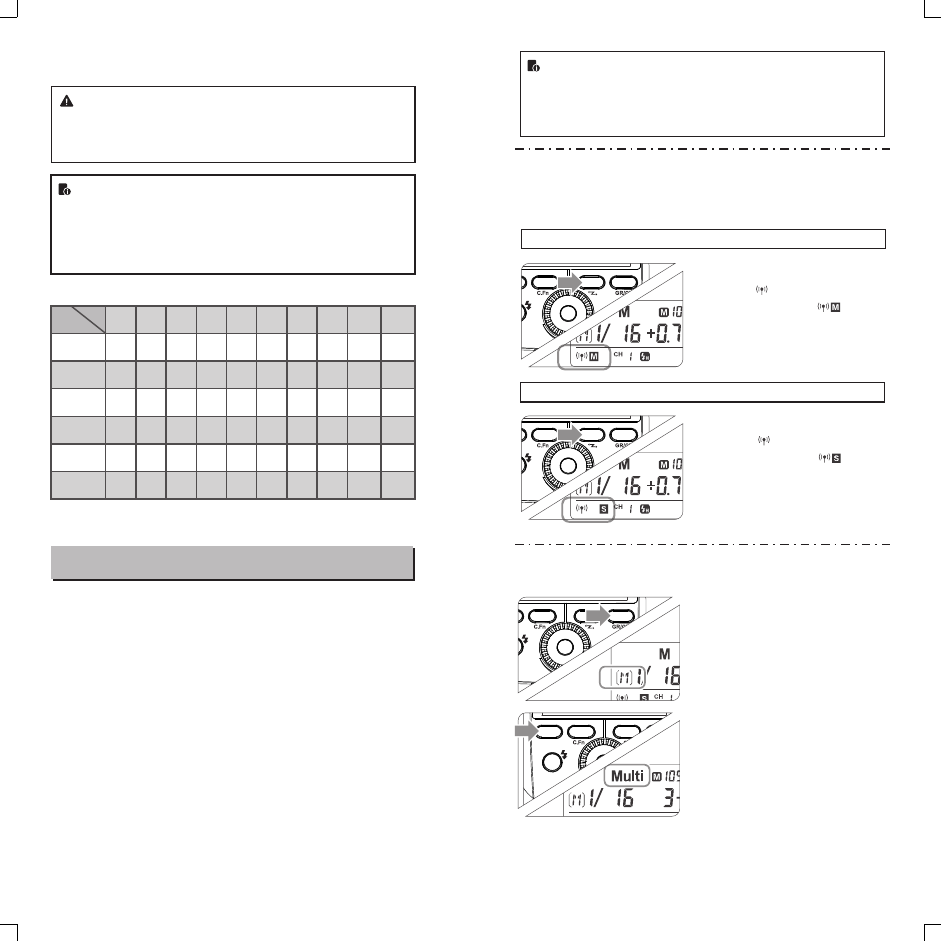
按< SLAVE >按钮选择
1M/A/B/C组别,再按
<MODE>按钮 选择主控单
元的闪光模式可以在 OFF /
TTL / M 之间进行切换,选
择其中一种作为主控单元的
闪光模式。
闪光次数/闪光频率=快门速度
例如,如果闪光次数是10,闪光频率是5Hz,快门速度则至少为2秒。
为防止闪光灯头过热并损坏,请勿执行连续10次以上的频闪闪光连
拍。闪光10次后,请让闪光灯至少冷却15分钟。如果您试图执行
连续10次以上的频闪闪光连拍,为防止闪光灯头过热,闪光可能自
动停止。如果发生了这种情况,请让闪光灯至少冷却15分钟。
● 反光很强的被摄体在暗背景前使用频闪闪光更加有效。
● 推荐使用三脚架和遥控开关。
● 频闪闪光时也可以使用“buLb”。
● 如果闪光次数显示为--,则闪光灯会连续闪光,直到快门或电池
耗尽。如下表所示,闪光次数将受到限制。
最大频闪闪光次数
1/4
1/8
1/16
1/32
1/64
1/128
1
6
14
30
60
90
90
2
3
14
30
60
90
90
3
2
6
30
60
90
90
4
2
4
20
50
80
90
5
2
3
10
50
80
90
6-7
2
3
8
40
70
90
8-9
2
3
5
12
60
80
闪
光输出 10
2
2
3
5
20
70
2
2
3
5
10
30
Hz 60-99
20-50
2
2
3
5
10
20
无线闪光拍摄:无线电(2.4G)传输
● 无线电创意系统,支持创建三个从属单元组,并实现TTL自动闪
光。您可以通过TTL自动闪光轻松获取多种照明效果。
● 使用主控单元按组分别设置的任何TTL自动闪光,手动闪光和频闪
闪光设置都会被自动传输到从属单元。因此,在拍摄时无需操作从
属单元。只需在主控单元上对每个从属组进行单独设置就可完成。
● 将此产品设置为主控单元时,可以在TTL/M/Multi/OFF四种
闪光模式下工作。
TT350S使用神牛2.4G无线X系统,可以与本厂其他型号完美结合使用。
*TT350S 作为主控单元,可控制从属单元型号:
AD600、AD600M、AD360II-C、AD360II-N 、V860IIS、V850II、
TT685S、TT600。
*TT350S 作为从属单元,可受控主控单元型号:
X1T-S、V860IIS、V850II、TT685S、TT600。
● 即使有多个从属单元,主控单元也可通过无线控制控制所有
的闪光灯。
● 本说明手册中,“主控单元”指安装在相机上的闪光灯,
“从属单元”指通过无线控制的闪光灯。
从属单元设置
1、无线设置
您可以在普通闪光和无线闪光之间切换。对于普通闪光,请务必将无
线设置设为“关”。
主控单元设置
长按<SYNC>按钮2秒,直
1至< >闪烁。旋转调节旋
钮令频幕显示 < >,表
示主控单元。
长按<SYNC>按钮2秒,直
1至< >闪烁。旋转调节旋
钮令频幕显示 < >,表
示从属单元。
2、设置主控闪光灯的闪光模式
ZOOM SYNC SLAVE
SET
MODE ZOOM SYNC SLAVE
SET
长按<MODE>按钮2秒可切
2换至Multi模式。
- 11 - - 12 -
ZOOM SYNC SLAVE
SET
ZOOM SYNC SLAVE
SET
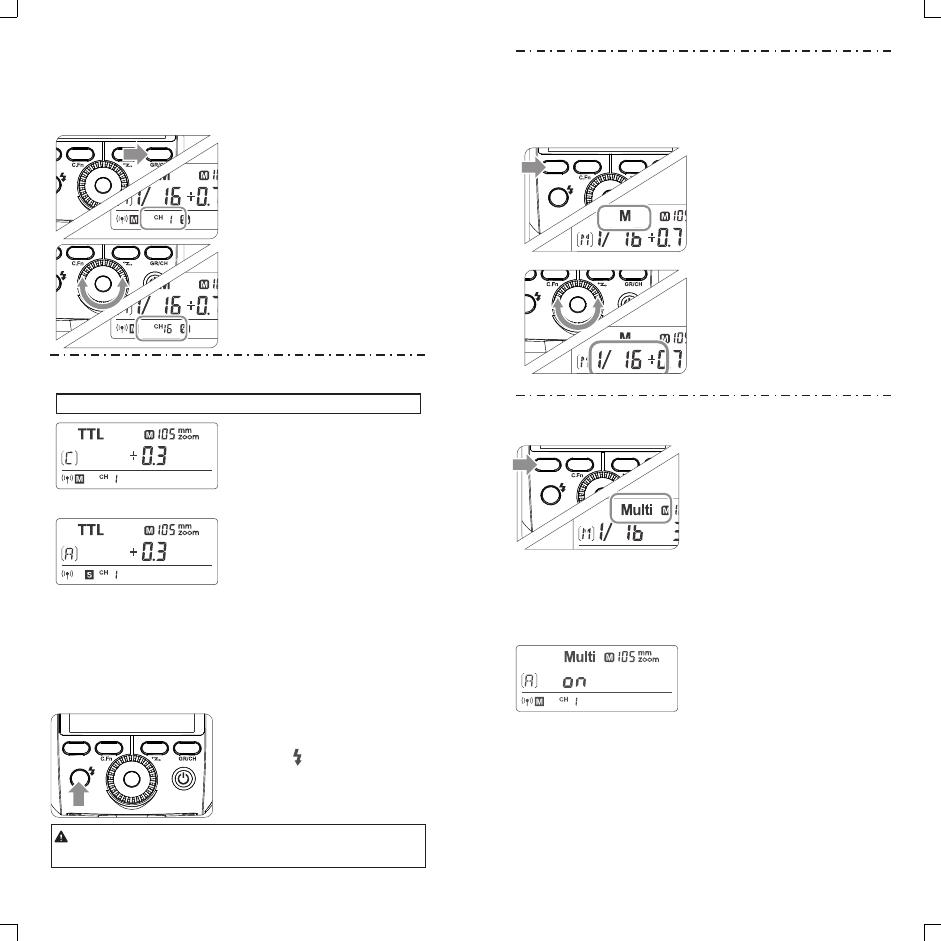
ZOOM SYNC SLAVE
SET
3、设置通讯频道
如果在拍摄现场不止一个无线闪光系统,您可以通过更改通讯频道来
防止信号干扰。保证主控单元和从属单元设置为相同的频道编号即
可。
长按<SLAVE>按钮2秒直至
1频道值闪烁,旋转调节旋钮
从1至16中选择频道。
按下<SET>设置按钮确定。
2
4、TTL: 全自动无线闪光拍摄
使用一个从属单元闪光
设置主控单元
1●将安装在相机上的T350S设
为主控单元。 (第12页)
●M/A/B/C都可独立设置为
TTL。
设置从属单元
2●将要被无线控制TT350S设
为从属单元。(第12页)
● 可以选择A/B/C。
检查传输频道
3 ● 将主控单元和从属单元的
频道设为一致。(第13页)
定位相机和闪光灯
4 ● 将其定位在(第15页)所
示的范围内。
ZOOM SYNC SLAVE
SET
检查操作
5● 按下主控闪光灯的试闪按
钮< >。
● 从属单元闪光。如果从属
单元不闪光,检查是否将其
放置在操作范围内。
如果从属单元附近有wifi路由器等2.4G的设备,可能会存在干扰导致闪
光灯漏闪。如有此情况发生请调节频道或者关闭2.4G设备。
MODE ZOOM SYNC SLAVE
SET
使用手动闪光的无线(多重闪光)拍摄,可以为每个从属单元(闪光
组)设定不同的闪光输出进行拍摄。在主控单元上设定所有参数。
5、M:手动无线闪光拍摄
将闪光模式设为<M>。
1● 按下<MODE>按钮,
选择M模式。
设置闪光输出
2● 旋转调节旋钮为闪光组设
定闪光输出。
拍摄照片
3● 各组以设定的闪光光比闪光。
MODE ZOOM SYNC SLAVE
SET
MODE ZOOM SYNC SLAVE
SET
6、Multi:手动无线闪光拍摄
设定<Multi>频闪模式。
1● 长按<MODE>按钮2秒,
令屏幕显示<Multi>。如再
长按<MODE>按钮2秒即退
出。
MODE ZOOM SYNC SLAVE
SET
闪光功率/闪光频率/闪光次
2数设置。
● 在M组状态下可设置闪光
功率、频率、次数。设定频
闪闪光设置。(第10页)
● 在A、B、C组只可通过
<MODE>按钮控制从属单
元的ON/OFF。
- 13 - - 14 -
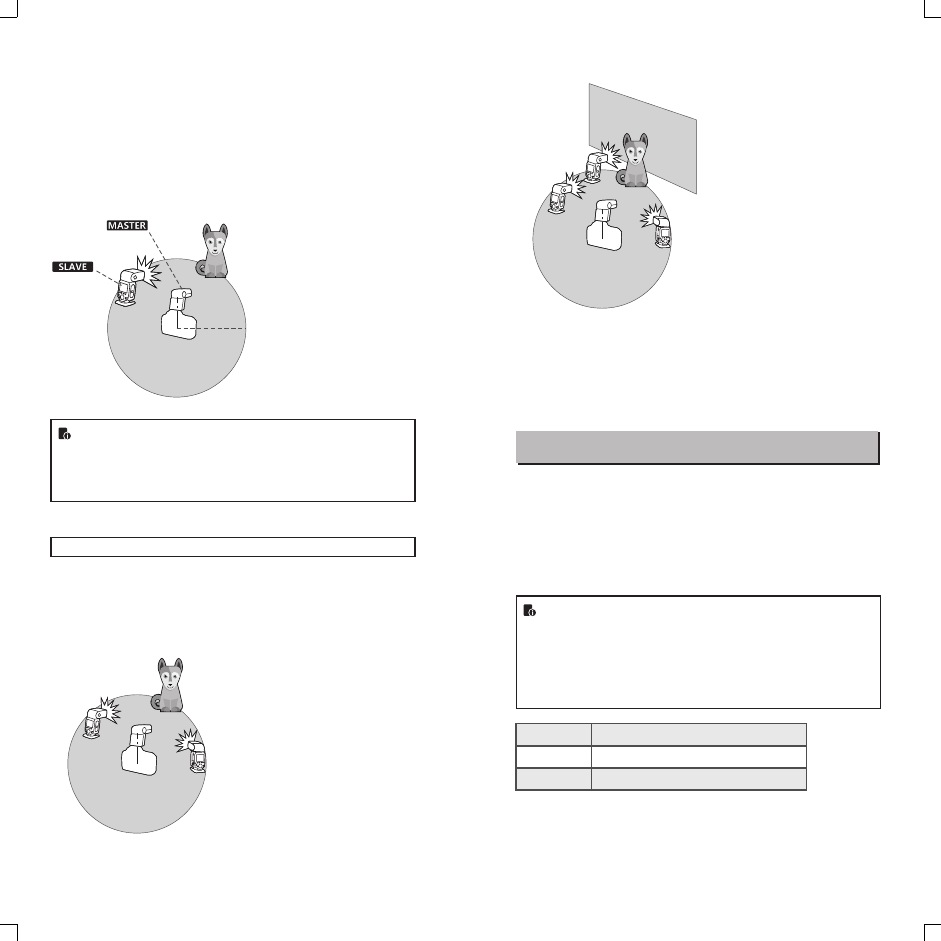
(主控)
(从属)
传输距离约30米
● 使用附带的微型支架定位从属单元。
● 开始拍摄前请进行测试闪光和试拍。
● 受从属单元的位置、周围环境、天气状况等影响,传输距离可能
更短。
可以将从属单元分割为两个或三个组同时进行TTL自动闪光拍摄。此
外,可以为各闪光组(最多3个组)设定并用不同的闪光模式拍摄。
● 用两个从属组进行自动闪光拍摄。
A
B
无线多重闪光拍摄
使具有无线电传输无线拍摄功能的闪光灯(主控/从属),可按照与普通
TTL自动闪光拍摄同样的方法,轻松利用高级无线多重闪光照明进行拍
摄。
基本相对位置和操作范围如图所示,只要将主控单元设定为<TTL>就
可以进行无线自动闪光拍摄。
定位和操作范围(无线闪光拍摄的示例)
● 使用一个从属单元进行自动闪光拍摄 A
B
C
● 用三个从属组进行自动闪光拍摄。
其他应用
自动辅助对焦灯
在低亮度或低对比度的拍摄情况下,闪光灯内置的自动对焦辅助灯将
开启,使自动对焦更容易。当对焦困难时,红色辅助对焦灯亮起;当
对焦准确,辅助对焦灯自动熄灭。
如想关闭自动辅助对焦功能,在C.Fn设置“AF”至“OFF”。
位置
中央
边缘
有效范围
0.6~4米
0.6~2.5米
● 不接相机时, TT350S的对焦灯不会亮;
● 在微单(如ILCE6000L、a7RII)类型的相机上使用, TT350S对
焦灯是不会亮的;
● 只有在单反(如a99、a77II)类型的相机上使用, TT350S对
焦灯才会自动点亮。
- 15 - - 16 -
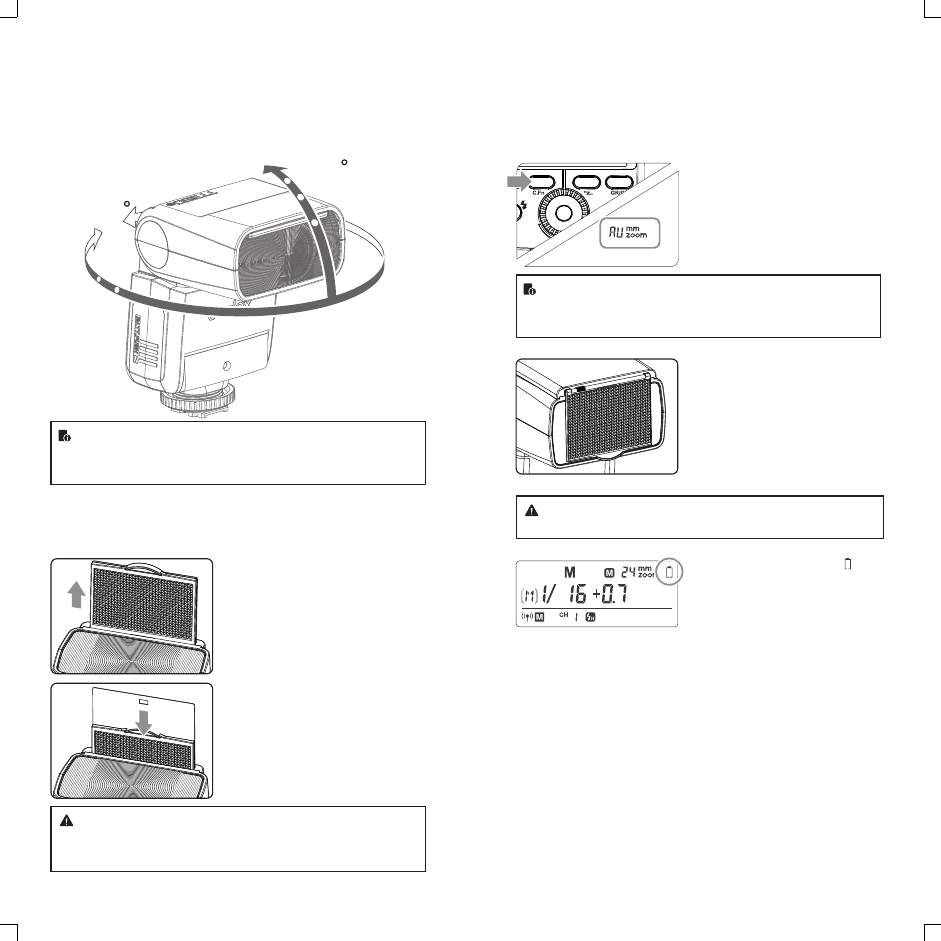
● 如果墙壁或天花板太远,反射闪光可能太弱并导致曝光不足。
● 墙壁或天花板应该是平坦的、白色的以利于高效的反射。如果反射
表面不是白色的,照片将出现偏色。
反射闪光
通过将闪光灯头指向墙壁或天花板,闪光在照亮被摄体前被墙面反射。
这可以减轻被摄物体背后的阴影,获得更自然的摄影效果。称之为反射
闪光。
旋转闪光灯头来设置反射方向。
270
-7-90
创建眼神光
使用眼神光板,您可以在被摄体的眼睛中创建眼神光以使面部表情更
加生动。
将闪光灯头向上旋转90°。
1
拉出广角散光板,同时弹出
2眼神光板。
推入广角散光板。
3● 仅推入广角散光板。
● 按照反射闪光中相同的步
骤进行。
● 请将闪光灯头向前指然后向上旋转90度。如果左右旋转闪光灯头就
不会产生眼神光。
● 要获得最好的眼神光效果,被摄体不能处于相机1.5米/4.9英尺以内。
ZOOM:设置闪光覆盖范围并使用广角散光板
该闪光灯有两种变焦方式:自动变焦和手动变焦。可以设置闪光覆盖范
围以匹配24-105毫米的镜头焦距。自动变焦时,焦距会随相机变焦镜
头的改变而变化,以提供最佳闪光效果。同样,使用内置的广角散光
板,闪光覆盖范围可以扩展为14毫米广角镜头。
手动变焦时,按下<ZOOM>
设置按钮。
● 转动调节旋钮更改闪光覆盖范围。
● 在显示< AU>状态下,将自动设置
闪光覆盖范围。
● 如果手动设置闪光覆盖范围,确保其覆盖镜头焦距,这样照片就不
会出现阴影边缘。
● 低电量警示时,ZOOM值将无法调整,自动固定在24mm。
使用广角散光板
拉出广角散光板并将其置于闪光灯
头上。闪光覆盖范围将扩展至14毫
米。
● 同时弹出眼神光板。请推回眼神
光板。
电池电量低时,电池符号< > 会闪
烁,此时请更换电池。
低电量警示时,ZOOM值将无法调
整,自动固定在24mm。
ZOOM SYNC SLAVE
SET
- 17 - - 18 -
● 当拉出广角散光板, ZOOM值会固定在14mm, <ZOOM>按钮不
起作用。

高速同步模式下,激活热保护功能的连续闪光次数:
2. 其他保护
● 为了保证设备安全的工作,系统时刻进行预防保护,以下提示符号
供您参考:
1. 热保护
● 为防止闪光灯头过热并损坏,请勿在1/1功率时进行超过30次的快
速连续闪光。30次连续闪光后,要让闪光灯至少冷却10分钟。
● 如您在进行超过30次连续闪光后马上继续进行更多次闪光,内部的
防过热功能可能会被激活,使充电时间变为10秒以上。如果发生这
种现象,请让闪光灯冷却约10分钟,闪光灯便会恢复正常。
● 热保护启动后,显示屏上 的符号会显示。
激活热保护功能的连续闪光次数:
C.Fn:设置自定义功能
请对照以下图表本机应用栏,使用自定义功能来完成设置。
设置符号
ON
OF
ON
OF
10秒
OF
ON
功能
自动休眠(standby)
自动对焦辅助光闪光
背光控制
设置和说明
启动
关闭
启动
关闭
10秒后自动熄灭
一直熄灭
一直点亮
自定义
功能符号
ST
AF
BL
1. 长按< ZOOM >按钮2秒,直到显示C.Fn菜单。
2. 旋转调节旋钮选择自定义功能。
3. 按< SET >设置按钮,自定义功能编号闪烁。
4. 旋转调节旋钮设置想要的编号,按<SET>按钮确定。
5. 按<ZOOM>退出C.Fn菜单。
保护功能
功率
1/1
1/2(+0.3,+0.7);
1/4(+0.3,+0.7)
1/8(+0.3,+0.7);
1/16(+0.3,+0.7)
次数
15
20
30
40
功率
1/1
1/2 +0.7
1/2 +0.3
1/2
1/4(+0.3,+0.7)
1/8(+0.3,+0.7)
1/16(+0.3,+0.7)
1/32(+0.3,+0.7)
1/64(+0.3,+0.7)
1/128(+0.3,+0.7)
次数
30
40
50
60
100
200
300
500
1000
警示内容
闪光灯回电系统出现问题,无法回电引闪,请重新开机,如无法
解决请维修
闪光灯管两端电压过高,请维修
固件升级有误,请进行正确固件升级
LCD显示
E1
E3
E9
● 注:本品出厂不配USB升级线,请另行购买。普通的USB线可使
用,本产品USB口为Micro USB 接口。
本机通过USB插座可进行固件升级。软件最新公告及说明将会发布在
官方网站上。
固件升级
查看版本号: 按住<MODE>按钮然后开机, 显示U-1.0, 表示1.0版
本。
- 19 - - 20 -

规格参数
型号
· 类型
兼容相机
闪光指数
(1/1档位;105mm焦距)
闪光覆盖范围
闪光持续时间(t0.1)
· 曝光控制
曝光控制系统
闪光曝光补偿(FEC)
同步方式
频闪闪光
· 无线闪光(无线电2.4G传输)
无线功能
可控制从属单元组
传输范围(约)
频道
· 自动对焦辅助光
有效范围(约)
· 电源
AA型电池
回电时间
全功率闪光次数
节能
· 同步触发方式
· 尺寸
体积
净重(不含电池)
TT350S
SONY索尼 (参考兼容相机列表)
36(m ISO 100)
24 – 105毫米
•自动变焦(自动设置适合镜头焦距和图像尺寸的闪
光覆盖范围)
•手动变焦
•闪光灯头旋转/倾斜,水平0~270°,
垂直-7°~90°(反射闪光)
1/350秒-1/20000秒
TTL 自动闪光、手动闪光
手动,闪光包围曝光:在±3档间以1/3档为增量调节
(可以组合使用手动闪光曝光补偿)
高速同步(最高1/8000秒),前帘同步,后帘同步
具备(次数:90次;99Hz)
主控单元,从属单元,关闭
3组:A, B,C
≤30 米
16组:1~16
中央:0.6 -4米 / 边缘:0.6-2.5米
镍氢电池(推荐)或LR6类型碱性电池*2节
约0.1-2.2秒(松下eneloop镍氢电池),闪光灯准备
就绪,LED红色指示灯亮起
约210次(2500mA镍氢电池)
闪光灯在无人操作90秒左右将会自动关闭电源。
设置为从属单元时60分钟进入休眠状态。
热靴,光控
140*62*38 mm
200g
故障排除指南
如果遇到问题,请参阅此故障排除指南。
闪光灯不充电。
● 电池安装方向错误。
→以正确的方向安装电池。
● 闪光灯的内置电池耗尽。
→如果闪光灯LCD屏幕上< >显示并闪烁,表明需要更换电池。
闪光灯不闪光。
● 闪光灯没有牢固地安装在相机上。
→将闪光灯的固定座牢固地安装在相机上。
● 闪光灯和相机的电子触点变脏。
→请清洁触点。
电源自动关闭。
● 当灯作为主控单元时,90秒无操作后,自动电源关闭功能生效。
→半按快门按钮或机身任意按键唤醒。
● 作为从属单元在60分钟无任何操作时,闪光灯会进入休眠状态。
→可按机身任意按键唤醒。
自动变焦不工作。
● 闪光灯没有牢固地安装在相机上。
→将闪光灯的固定座牢固地安装在相机上。
闪光曝光不足或过度。
● 使用高速同步。
→使用高速同步,有效的闪光范围会更小。确保被摄体位于显示
的有效闪光范围内。
● 闪光灯使用手动曝光模式。
→改为TTL模式或修改闪光输出功率设置。
相片出现暗角或者被摄物体只有局部能照亮。
● 相机镜头焦距超出闪光灯的覆盖范围。
→请检查闪光灯当前的覆盖焦距。本产品的灯头变焦范围是中画
幅系统的24-105mm,您可以尝试拉出广角闪光板,以扩大闪
光范围。
- 21 - - 22 -

兼容相机列表
本机可兼容以下SONY相机型号:
注: 1. 此表格仅列举目前已测试的相机型号,未涵盖所有SONY相机。
其他相机型号,用户可自行测试。
2. 本公司保留未来修改此表格内容的权利。
● 闪光灯在工作时,如发现异常,应立即关掉电源,查明原因。
● 灯体应避免震动,平时注意表面除尘。
● 灯体稍有发热为正常现象,无特别需要时,勿连续引闪。
● 闪光灯的所有维修概由本厂指定可供原厂配件之维修部负责。
● 1年保修,消耗品如灯管等,不在1年保修范围。
● 经发现,擅自检修此闪光灯的,将取消闪光灯之一年保修期,维修
需要收取相关费用。
● 如果本品出现故障或者被水淋湿,在专业人员维修后方可继续使
用。
● 如有技术更改,恕不另行通知。
维护保养
ILCE6000L
α7RII α7R α58 α99
- 23 - - 24 -
α77 II
RX10

- 22 -
Always keep this product dry. Do not use in rain or in damp
conditions.
This product contains high-voltage electronic parts. Touching
the high-voltage circuit inside it may result in electric shock. Do
not disassemble. Should repairs become necessary, this
product must be sent to an authorized maintenance center.
Stop using this product if it breaks open due to extrusion, falling
or strong hit. Otherwise, electric shock may occur if you touch
the electronic parts inside it.
Do not fire the flash directly into the eyes (especially those of
babies) within short distances. Otherwise visual impairment
may occur. When taking pictures for babies, keep the flash unit
at least 1 meter (3.3 feet) away from them. Using bounce flash
to reduce light intensity is also recommended.
Do not use the flash unit in the presence of flammable gases,
chemicals and other similar materials. In certain circumstances,
these materials may be sensitive to the strong light emitting
from this flash unit and fire or electromagnetic interference may
result.
Do not leave or store the flash unit in places where the ambient
temperature reads over 50°C (e.g. in automobile). Otherwise
the electronic parts may be damaged.
Thank you for purchasing this product.
This TT350S camera flash applies to SONY series cameras and is
compatible with TTL autoflash. With this TTL compatible flash, your
shooting will become simpler. You can easily achieve a correct flash
exposure even in complex light-changing environments. This
camera flash features:
● GN36 (m ISO 100, @105mm).
● Fully support Sony TTL camera flash. Workable as Master or
Slave unit in a wireless flash group.
● With built-in 2.4GHz wireless remote system to support
transmitting and receiving.
● Provided multiple functions, include manual flash, multi flash, HSS
(up to 1/8000s), second curtain sync, FEC, etc.
● Support with firmware upgrade.
For Your Safety
Foreword
- 25 - - 26 -

- 22 -
Foreword
For Your Safety
Name of Parts
Body
Control Panel
LCD Panel
What's in the Box of TT350S?
Separately Sold Accessories
Attaching to a Camera
Power Management
Flash Mode: TTL Autoflash
FEC (Flash Exposure Compensation)
High-Speed Sync
Second-Curtain Sync
Flash Mode – M: Manual Flash
Flash Mode – Multi: Stroboscopic Flash
Wireless Flash Shooting: Radio (2.4G) Transmission
Wireless Settings
Setting Master Unit’s Flash Mode
Setting the Communication Channel
TTL: Fully Automatic Wireless Flash Shooting
M: Wireless Flash Shooting with Manual Flash
Multi: Wireless Flash Shooting with Manual Flash
Other Applications
Auto Focus Assist Beam
Bounce Flash
Creating a Catchlight
ZOOM: Setting the Flash Coverage and Using the Wide Panel
Low Battery Indicator
C.Fn: Setting Custom Functions
Protection Function
Firmware Upgrade
Technical Data
Troubleshooting
Compatible Camera Models
Maintenance
Contents
25
26
29
31
32
32
34
35
36
41
43
44
45
45
47
48
48
Conventions used in this Manual
● This manual is based on the assumption that both the camera and
camera flash’s power switches are powered on.
● Reference page numbers are indicated by “p.**”.
● The following alert symbols are used in this manual:
The Caution symbol gives supplemental information.
The Note symbol indicates a warning to prevent shooting
problem.
Thinklite TTL Camera Flash
E l e c t r o n i c C a m e r a F l a s h
- 27 - - 28 -
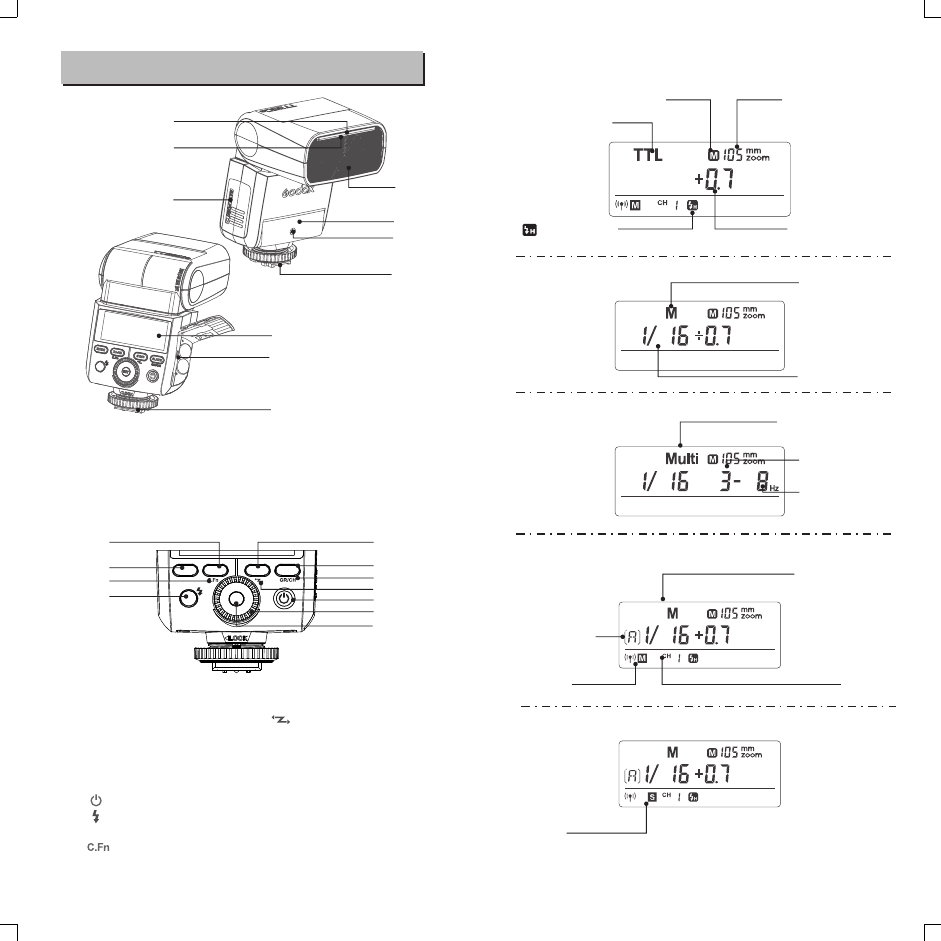
- 22 -
MODE ZOOM SYNC SLAVE
SET
01. Catchlight Panel
02. Built-in Wide Panel
03. Flash Head
04. Optic Control Sensor
05. Focus Assist Beam
06. Hotshoe
07. LCD Panel
08. Lock Ring
09. Battery Compartment
10. USB Port
● Body
11. <MODE>Mode Selection Button
12. <ZOOM>Zoom Selection Button
13.<SYNC>High-Speed Sync Button
14. <SLAVE> S1/S2 Optic Slave
Triggering Selection Button
(in non-wireless mode)
15. < > Power Switch
16. < > Test Button / Flash Ready
Indicator.
17. < >Custom Function Setting
Button (reusable button, long
press for 2 seconds)
18. < > Wireless Selection
Button (reusable button, long
press for 2 seconds)
19. <GR/CH> Group/Channel Button
(reusable button, in wireless
mode)
20. Select Dial
21.<SET> Set Button
● Control Panel
● LCD Panel
Name of Parts (1) TTL Autoflash
: Flash exposure
compensation (Page 33)
02
01
03
04
05
06
09
12 13
11
16
21
20
15
14
17 18
19
Zoom : zoom display (Page 42)
TTL : TTL autoflash
Focus length (Page 42)
Flash exposure
compensation amount
(2)M Manual Flash M : Manual flash
Manual flash output
(3)Multi Flash
Multi : Stroboscopic flash
Number of flashes
Flash frequency
Flash mode
Channel
(4) Radio Transmission Shooting
● Master Unit
Firing group
● Slave Unit
Master
Slave
- 29 - - 30 -
07
08
10
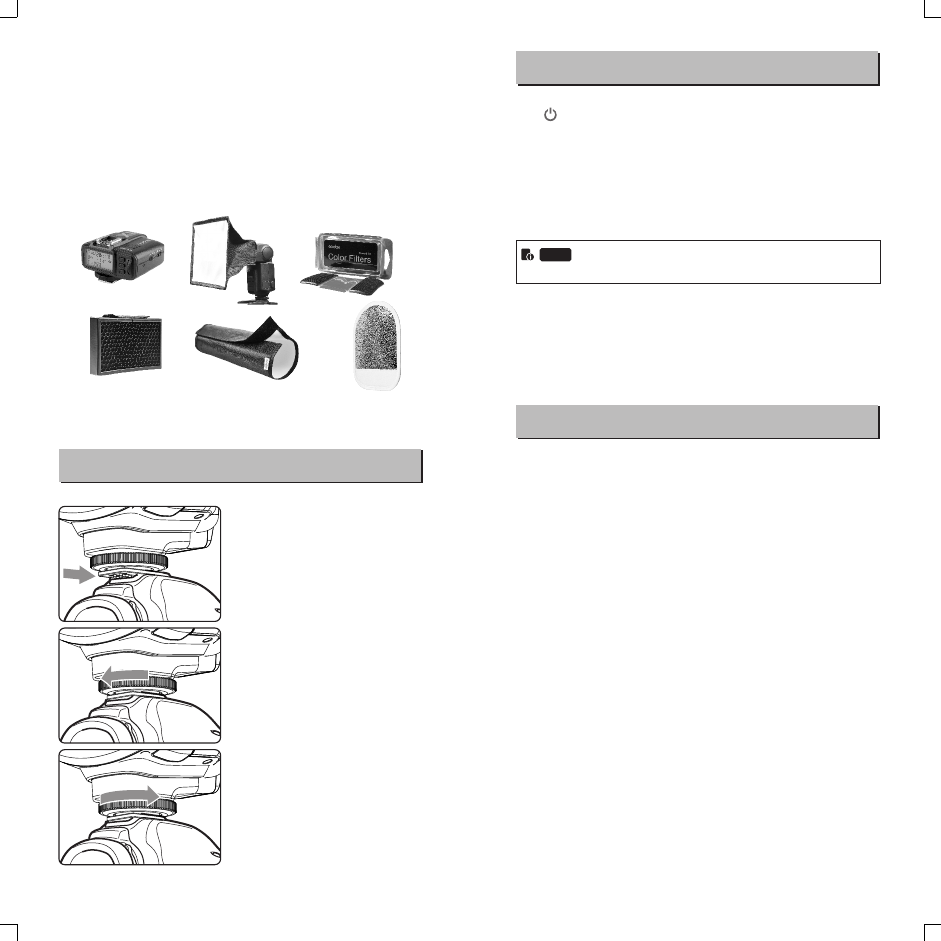
- 22 -
● Separately Sold Accessories
The product can be used in combination with the following
accessories sold separately, so as to achieve best photography
effects: X1T-S wireless flash trigger, Mini softbox, White & Silver
reflector, Honeycomb, Color gels, Snoot, etc.
● What’s in the Box of TT350S?
1. Flash unit 2. Mini stand 3. Protection case 4. Diffuser
5. Instruction manual
C.Fn
Attaching to a Camera
Attach the Camera Flash.
1● Slip the camera flash’s
mounting foot into the
camera’s hotshoe all the
way.
Secure the Camera Flash.
2● Rotate the lock ring on the
mounting foot until it locks
up.
Detach the Camera Flash.
3● Rotate the lock ring on the
mounting foot until it is
loosened.
Power Management
Use Power Switch to power the flash unit on (Long press the
button for one second) or off. Turn off if it will not be used for an
extended period of time. Setting as a master flash, it will turn the
power off automatically after a certain period (approx. 90 seconds)
of idle use. Pressing the camera shutter halfway or pressing any
flash button will wake up the flash unit. Setting as a slave flash, it
will enter sleep mode after a certain period (adjustable, 60 minutes
by default) of idle use. Pressing any flash button will wake it up.
Disabling Auto Power Off function is recommended
when the flash is used off camera. (C.Fn-ST, Page 43)
Flash Mode: TTL Autoflash
This flash has three flash modes: TTL, Manual (M), and Multi
(Stroboscopic). In TTL mode, the camera and the flash will work
together to calculate the correct exposure for the subject and the
background. In this mode, multiple TTL functions are available:
FEC, HSS, second curtain sync, etc.
* Press <MODE> Mode Selection Button and three flash modes will
display on the LCD panel one by one with each pressing.
TTL Mode
Press <MODE> Mode Selection Button to enter TTL mode. The
LCD panel will display <TTL>.
● Press the camera release button halfway to focus.
● When the shutter button is fully pressed, the flash will fire a pre-
flash that the camera will use to calculate exposure and flash
output the instant before the photo is taken.
Display“HI”: When the flash output value is up to the maximum
value, “HI”will be displayed and blinking for 3 seconds. Adjust
the camera’s parameters if underexposure appears.
Display“Lo”: When the flash output value is up to the minimum
value, “Lo”will be displayed and blinking for 3 seconds. Adjust the
camera’s parameters if overexposure appears.
- 31 - - 32 -
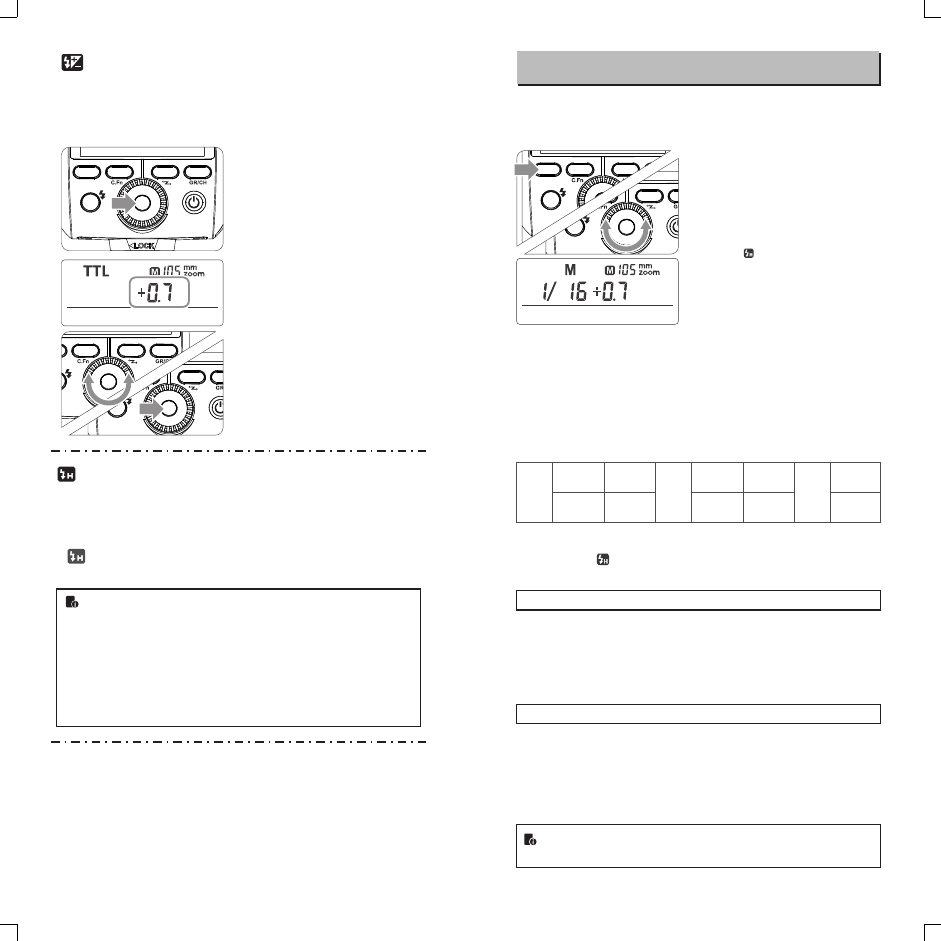
- 22 -
FEC: Flash Exposure Compensation
With FEC function, this flash can adjust from -3 to +3 in 1/3rd stops.
It is useful in situations where minor adjusting of the TTL system is
needed based on the environment.
Setting FEC:
Turn the Select Dial to set the
2amount.
● “0.3”means 1/3 step,
“0.7”means 2/3 step.
● To cancel the flash
exposure compensation,
set the amount to “+0”.
Press < SET > button again
3to confirm the setting.
Press the SET Button and
1the flash exposure
compensation amount will be
highlighted on the LCD panel.
● With high-speed sync, the faster the shutter speed, the
shorter the effective flash range.
● Multi flash mode cannot be set in high-speed sync mode.
● Over-temperature protection may be activated after 15
consecutive high-speed sync flashes.
● Try to avoid using high-speed sync flash, which will cut
short flash tube’s lifetime.
High-Speed Sync
High Speed Sync (Hss flash) enables the flash to synchronize with
all camera shutter speeds. This is convenient when you want to use
aperture priority for fill-flash portraits.
Press the <SYNC> button to turn on high-speed sync flash and
< > is displayed. Then, adjust the SONY camera’s shutter to
achieve high-speed sync flash.
Second-Curtain Sync
With a slow shutter speed, you can create a light train following the
subject. The flash fires right before the shutter closes.
● Set Sony camera to Rear mode.
The flash output is adjustable from 1/1 full power to 1/128th power
in 1/3rd stop increments. To obtain a correct flash exposure, use a
hand-held flash meter to determine the required flash output.
M: Manual Flash
Press < MODE > button so
1that < M > is displayed.
Turn the Select Dial to choose
2a desired flash output amount.
In high-speed sync mode,
the adjustable flash range is
1/16~1/1.
Figures displayed when reducing flash output level→
←Figures displayed when increasing flash output level
1/41/21/1
1/1-0.3
1/2+0.7
1/1-0.7
1/2+0.3
1/2-0.3
1/4+0.7
1/2-0.7
1/4+0.3
······
······
Flash Output Range
The following table makes it easier to see how the stop changes in
terms of f/stop when you increase or decrease the flash output. For
example, when you decrease the flash output to 1/2, 1/2-0.3, or 1/2-
0.7, and then increase the flash output to more than 1/2, 1/2+0.3,
1/2+0.7, and 1/1 will be displayed.
Optical S1 Secondary Unit Setting
In M manual flash mode, press the <SLAVE> button so that this
flash can function as an optic S1 secondary flash with optic sensor.
With this function, the flash will fire synchronously when the main
flash fires, the same effect as that by the use of radio triggers. This
helps create multiple lighting effects.
Optical S2 Secondary Unit Setting
Press the <SLAVE> button so that this flash can also function as an
optic S2 secondary flash with optic sensor in M manual flash mode.
This is useful when cameras have pre-flash function. With this
function, the flash will ignore a single “preflash” from the main flash
and will only fire in response to the second, actual flash from the
main unit.
● S1 and S2 optic triggering and off camera high-speed
mode are only available in M manual flash mode.
In the M mode, high-speed sync and second curtain sync functions
can be achieved.
- 33 - - 34 -
ZOOM SYNC SLAVE
SET
MODE ZOOM SYNC SLAVE
SET
MODE ZOOM SYNC SLAVE
SET
MODE ZOOM SYNC SLAVE
SET
MODE ZOOM SYNC SLAVE
SET

- 22 -
Set the flash frequency and
3flash times.
● Press the SET Button to
select the flash frequency.
Turn the Select Dial to set
the number.
● Press the SET Button
again to select the flash
times. Turn the Select Dial
to set the number.
Multi: Stroboscopic Flash
With stroboscopic flash, a rapid series of flashes is fired. It can be
used to capture a multiple images of a moving subject in a single
photograph.
You can set the firing frequency (number of flashes per sec.
expressed as Hz), the number of flashes, and the flash output.
Press <MODE> button so
1that <Multi> is displayed.
Turn the Select Dial to choose
2a desired flash output.
Calculating the Shutter Speed
During stroboscopic flash, the shutter remains open until the firing
stops. Use the formula below to calculate the shutter speed and set
it with the camera.
For example, if the number of flashes is 10 and the firing frequency is
5 Hz, the shutter speed should be at least 2 seconds.
Number of Flashes / Flash Frequency = Shutter Speed
To avoid overheating and deteriorating the flash head, do not
use stroboscopic flash more than 10 times in succession.
After 10 times, allow the camera flash to rest for at least 15
minutes. If you try to use the stroboscopic flash more than 10
times in succession, the firing might stop automatically to
protect the flash head. If this happens, allow at least 15
minutes’ rest for the camera flash.
● Stroboscopic flash is most effective with a highly reflective
subject against a dark background.
● Using a tripod and a remote control is recommended.
● Stroboscopic flash can be used with“buLb”.
● If the number of flashes is displayed as “--”, the firing will
continue until the shutter closes or the battery is
exhausted. The number of flashes will be limited as shown
by the following table.
Maximum Stroboscopic Flashes:
1/4
1/8
1/16
1/32
1/64
1/128
1
6
14
30
60
90
90
2
3
14
30
60
90
90
3
2
6
30
60
90
90
4
2
4
20
50
80
90
5
2
3
10
50
80
90
6-7
2
3
8
40
70
90
8-9
2
3
5
12
60
80
10
2
2
3
5
20
70
2
2
3
5
10
30
Hz 60-99
20-50
2
2
3
5
10
20
Flash
output
Wireless Flash Shooting: Radio (2.4G) Transmission
● You can set up three slave groups for TTL autoflash shooting.
With TTL autoflash, you can easily create various lighting effects.
● Any flash settings for the slave units on the master flash in TTL
mode will be automatically sent to the slave units. So the only
thing you need to do is to set the master unit for each slave group
without any operation for the slave units at all during the shooting.
● This flash can work in TTL /M /Multi / OFF flash modes when set
as a master unit.
Master Unit Setting
1. Wireless Settings
You can switch between normal flash and wireless flash. For normal
flash shooting, be sure to set the wireless setting to OFF.
Long Press the <SYNC>
1button for 2 seconds so that
< > is blinking. Turn the
Select Dial until the < >
is displayed on the LCD
panel, which means the
master unit.
● Even with multiple slave units, the master unit can control
all of them via wireless.
● In this user manual, “master unit” refers to the camera flash
on a camera and “slave unit” will be controlled by the
master unit.
When using Godox 2.4G wireless X system, TT350S is perfectly
compatible with other products of our company.
As a master unit, TT350S can control the following slave unit
models: AD600, AD600M, AD360II-C, AD360II-N, V860IIS, V850II,
TT685S, TT600.
As a slave unit, TT350S can be controlled by the following master
unit models: X1T-S, V860IIS, V850II, TT685S, TT600.
- 35 - - 36 -
MODE ZOOM SYNC SLAVE
SET
MODE ZOOM SYNC SLAVE
SET
MODE ZOOM SYNC SLAVE
SET
MODE ZOOM SYNC SLAVE
SET
ZOOM SYNC SLAVE
SET
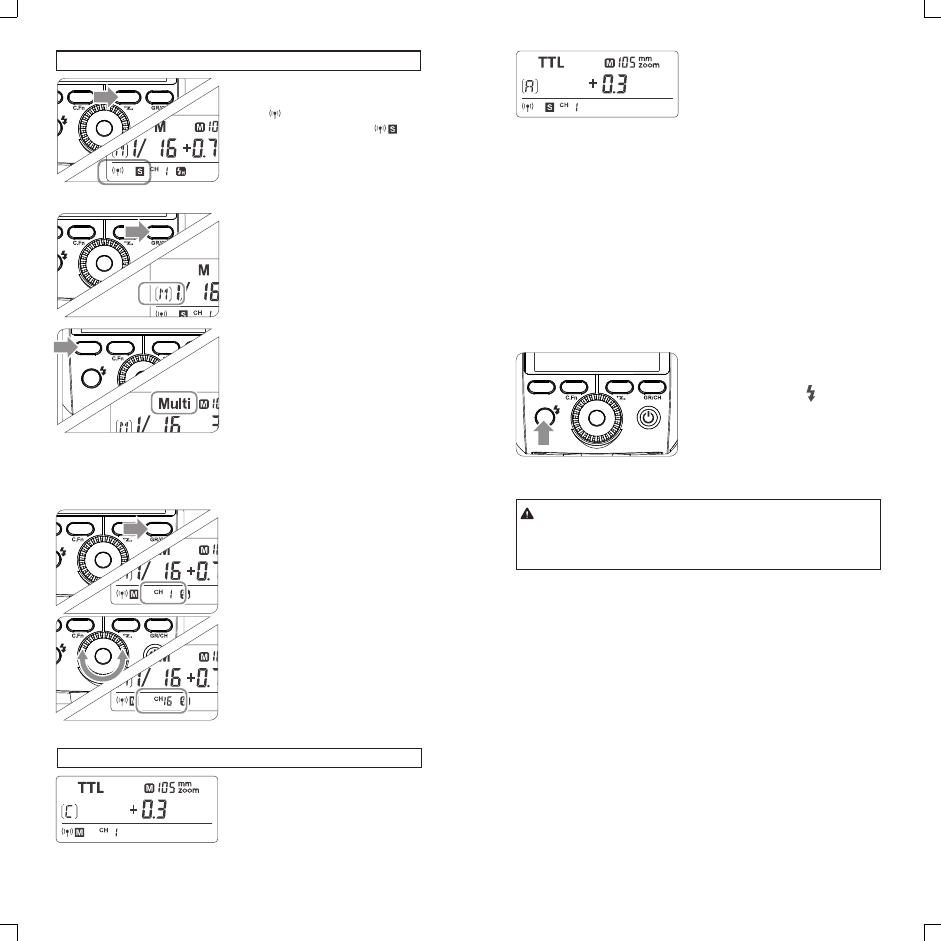
- 22 -
Long Press the <SYNC>
1button for 2 seconds so that
< > is blinking. Turn the
Select Dial until the < > is
displayed on the LCD panel,
which means the slave unit.
Slave Unit Setting
Press the <SLAVE> Button to
1ch o o se th e g r oup f r o m
M/A/B/C. Then, press the
< MODE > Button so that the
master unit can work in OFF /
TTL / M flash mode. Choose
one of them as the flash
mode of master unit.
3. Setting the Communication Channel
If there are other wireless flash systems nearby, you can change the
channel IDs to prevent signal interference. The channel IDs of the
master unit and the slave unit(s) must be set to the same.
Long press the <SLAVE>
1Button for 2 seconds until the
channel IDs is blinking. Turn
the Select Dial to choose a
channel ID from 1 to 16.
Press the <SET> button to
2confirm.
2. Setting Master Unit’s Flash Mode
Press the <MODE> Button for
22 seconds to switch to Multi
mode.
Autoflash Shooting with One Slave Unit
4. TTL: Fully Automatic Wireless Flash Shooting
Master Unit Setting
1● Attach a TT350S camera
flash on the camera and set it
as the master unit. (Page 36)
● M/A/B/C can be set as
TTL mode independently.
Slave Unit Setting
2● Set the TT350S that to be
controlled as the wireless
slave unit. (Page 37)
● The slave unit can be set
as A/B/C.
Check the communication
3channel
● If the master unit and
slave unit(s) are set to a
different channel, set them
to the same channel.
(Page 37)
Position the camera and
4flashes
● Position the camera and
flashes as the picture
shows. (Page 40)
Check the flash operation
5● Press the master unit’s
Test Button< >.
● Then, the slave unit will
fire. If not, adjust the slave
unit’s angle toward the
master unit and distance
from the master unit.
The slave unit might be out of order or fire an unwanted flash
due to the nearby wifi routers or other 2.4G equipments. If in
this case, please adjust the flash’s channel or turn off the 2.4G
equipments.
- 37 - - 38 -
ZOOM SYNC SLAVE
SET
MODE ZOOM SYNC SLAVE
SET
ZOOM SYNC SLAVE
SET
ZOOM SYNC SLAVE
SET
ZOOM SYNC SLAVE
SET
MODE ZOOM SYNC SLAVE
SET
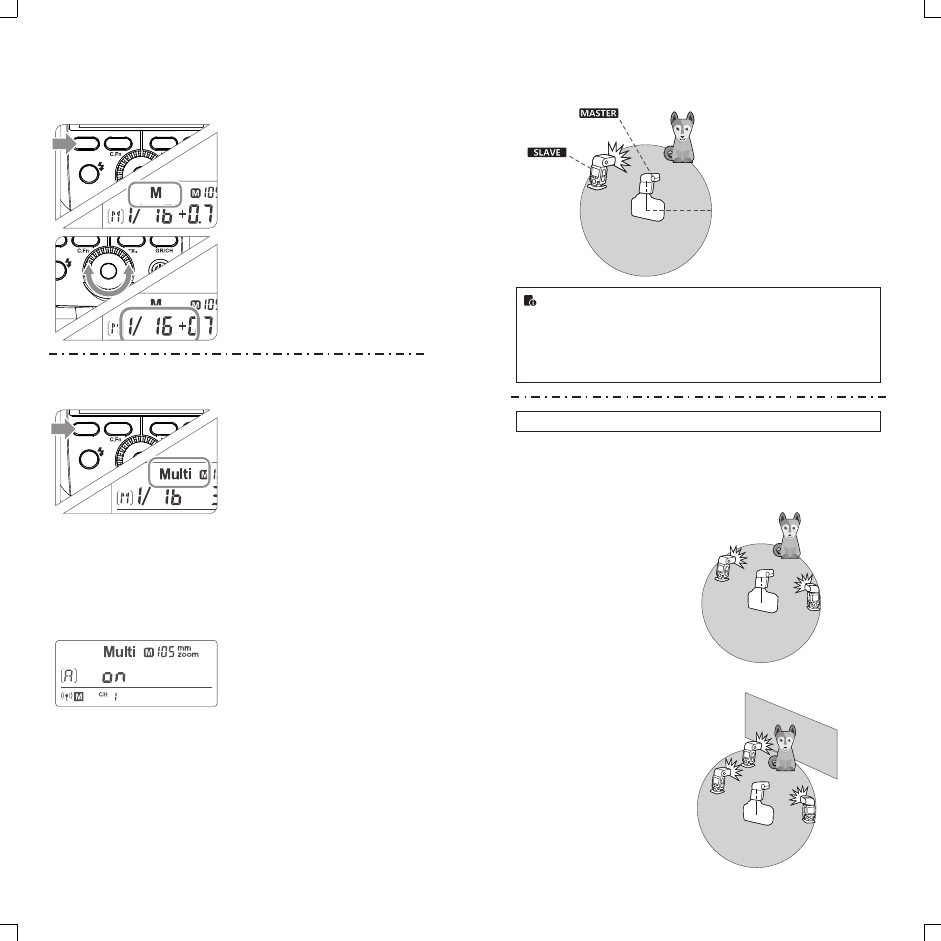
- 22 -
Setting <Multi>
1stroboscopic flash.
● Long press the <MODE>
button for 2 seconds so that
<Multi> is displayed. Long
press the <MODE> button
for 2 seconds again to exit.
5. M: Wireless Flash Shooting with Manual Flash
This describes wireless (multiple shooting) using manual flash. You
can shoot with a different flash output setting for each slave unit
(firing group). Set all parameters on the master unit.
Setting the flash mode to
1<M>
● Press the <MODE> Button
to set the flash to M mode.
Setting flash output
2● Turn the Select Dial to set
the flash output of the
groups.
Taking the picture
3● Each group fires at the set
flash ratio.
Using a flash (master/slave) with a radio transmission wireless
shooting function make it easy to shoot with advanced wireless
multiple flash lighting, in the same way as TTL autoflash shooting.
The basic relative position and operation range are as shown in the
picture. You can then perform wireless TTL autoflash shooting just
by setting the master unit to <TTL>.
6. Multi: Wireless Flash Shooting with Manual
Flash
Setting flash output/flash
2frequency/flash times.
● Setting the flash
output/flash frequency/flash
times of the groups in the M
mode. Setting the multi flash
mode. (see Page35 )
● A, B and C group can only
control the ON/OFF of the
slave unit by pressing the
<MODE> Button.
Transmission distance is about 30m.
● Use the supplied mini stand to position the slave unit.
● Before shooting, perform a test flash and test shooting.
● The transmission distance might be shorter depending on
the conditions such as positioning of slave units, the
surrounding environment and whether conditions.
You can divide the slave units into two or three groups and perform
TTL autoflash while changing the flash ratio (factor). In addition, you
can set and shoot with a different flash mode for each firing group,
for up to 3 groups.
Wireless Multiple Flash Shooting
● Auto Shooting with Two Slave Groups
Slave/Master Unit's Positioning and Operation Range
● Autoflash Shooting with One Slave Unit
A
B
A
B
C
● Auto Shooting with Three Slave Groups
- 39 - - 40 -
MODE ZOOM SYNC SLAVE
SET
MODE ZOOM SYNC SLAVE
SET
MODE ZOOM SYNC SLAVE
SET
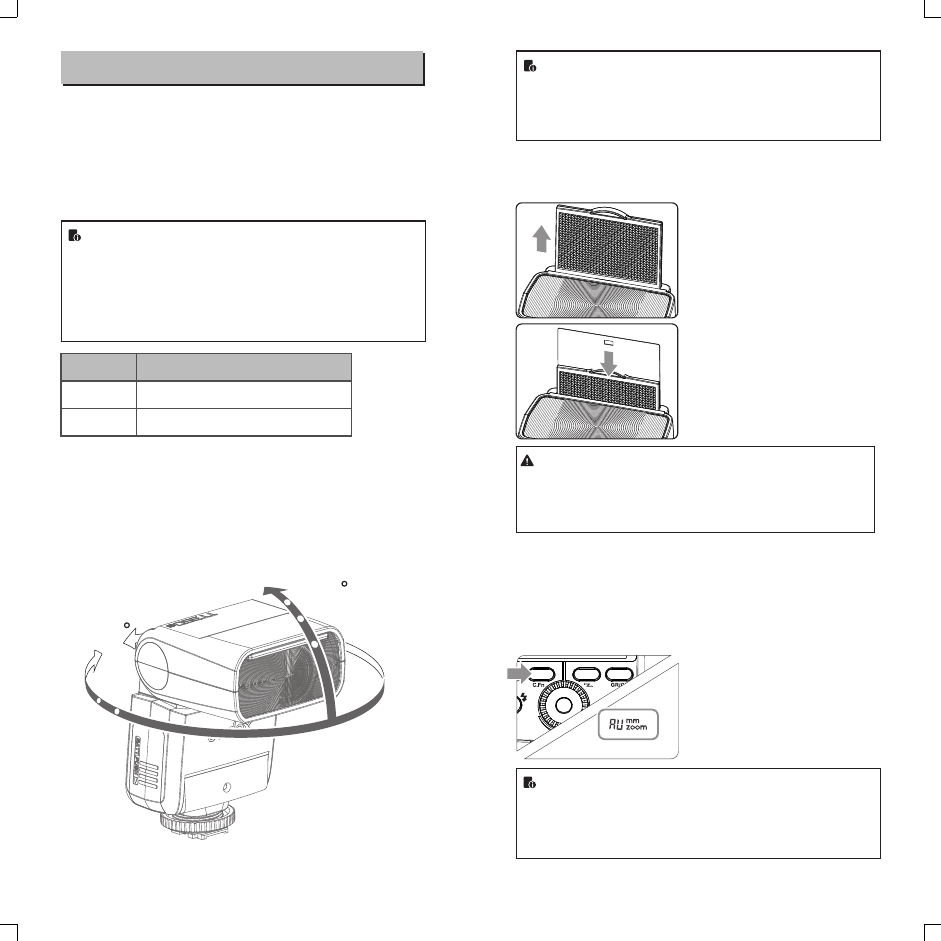
- 22 -
Other Applications
Auto Focus Assist Beam
In poorly-lit or low-contrast shooting environments, the built-in auto
focus assist beam will automatically light on to make it easier for
autofocus. The beam will light up only when autofocus is difficult
and get out as soon as the autofocus becomes correct.
If you want to turn off the auto focus assist beam, set the “AF” to
“OFF” on the C.Fn settings.
● When not attaching to the camera, the auto focus assist
beam of TT350S does not light up.
● When using on Interchangeable Lens Digital Cameras (e.g.
ILCE6000L, a7RII, etc.), the auto focus assist beam of
TT350S does not light up.
● When only using on DSLR cameras (e.g. a99, a77II, etc.),
the auto focus assist beam of TT350S does light up.
Position
Center
Periphery
Effective Range
0.6~4m
0.6~2.5m
Bounce Flash
By pointing the flash head toward a wall or ceiling, the flash will
bounce off the surface before illuminating the subject. This can
soften shadows behind the subject for a more natural-looking shot.
This is called bounce flash.
To set the bounce direction, hold the flash head and turn it to a
satisfying angle.
● If the wall or ceiling is too far away, the bounced flash might
be too weak and result in underexposure.
● The wall or ceiling should be a plain, white color for high
reflectance. If the bounce surface is not white, a color cast
may appear in the picture.
Creating a Catchlight
With the catchlight panel, you can create a catchlight in the subject’s
eyes to add life to the facial expression.
Point the flash head upward by
190°.
Pull out the wide panel. The
2catchlight panel will come out
at the same time.
Push the wide panel back in.
3
● Push in only the wide panel.
● Follow the same procedures
as for bounce flash.
● Point the flash head straight ahead and then upward by 90°.
The catchlight will not appear if you swing the flash head left
or right.
● For best catchlight effect, stay 1.5m/4.9ft away from the
subject.
ZOOM: Setting the Flash Coverage and Using
the Wide Panel
The flash coverage can be set automatically or manually. It can be
set to match the lens focal length from 24mm to 105mm. Also, with
the built-in wide panel, the flash coverage can be expanded for
14mm wide-angle lenses.
In Manual Zoom mode, press the
<ZOOM> button.
● Turn the Select Dial to change
the flash coverage.
● AUIf < > is displayed, the flash
coverage will be set
automatically.
● If you set the flash coverage manually, make sure it covers
the lens focal length so that the picture will not have a dark
periphery.
● When the low battery indicator is displayed, the ZOOM can
not be adjusted, it will constantly be 24mm.
- 41 - - 42 -
ZOOM SYNC SLAVE
SET
270
-7-90
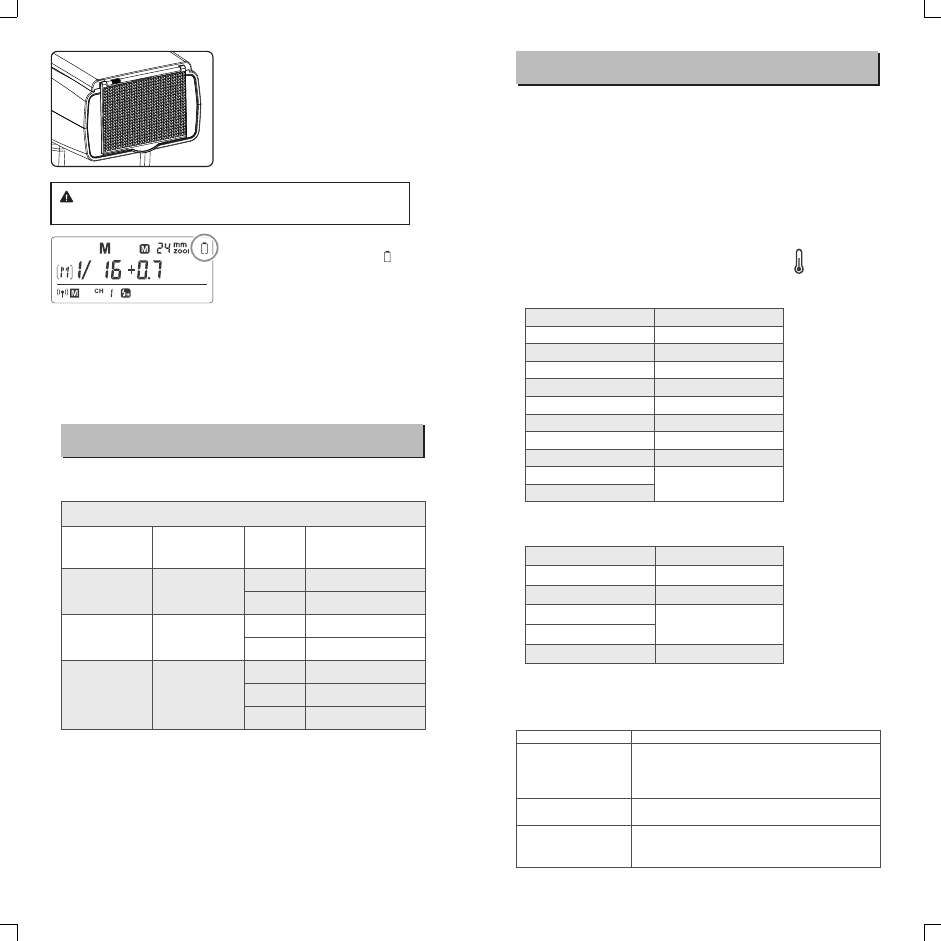
- 22 -
Using the Wide Panel
Pull out the wide panel and place it
over the flash head as shown. The
flash coverage will then be extended
to 14 mm.
● The catchlight panel will come out
at the same time. Push the
catchlight panel back in.
Low Battery Warning
If the battery power is low, < > will
appear and blink on the LCD panel.
P l e a s e r e p l a c e t h e b a t t e r y
immediately. When the low battery
indicator is displayed, the ZOOM can
not be adjusted, it will constantly be
24mm.
C.Fn: Setting Custom Functions
The following table lists the available and unavailable custom
functions of this flash.
ST
AF
BL
ON
OF
ON
OF
10 sec.
OF
ON
Auto sleep
(standby)
AF-assist beam
Backlighting
control
C.Fn Custom Functions
Custom Function
Signs
Function Setting No.Settings & Description
ON
OFF
ON
OFF
Off in 10 sec.
Always off
Always lighting
1. Press the < ZOOM > Button for 2 seconds until C.Fn menu is
displayed.
2. Turn the Select Dial to select the Custom Functions.
3. Press the <SET> Button and the Setting No. blinks.
4. Turn the Select Dial to set the desired number. Pressing the
<SET> Button will confirm the settings.
5. Press the <ZOOM> Button to exit.
Protection Function
1. Over-Temperature Protection
● To avoid overheating and deteriorating the flash head, do not fire
more than 30 continuous flashes in fast succession at 1/1 full
power. After 30 continuous flashes, allow a rest time of at least 10
minutes.
● If you fire more than 30 continuous flashes and then fire more
flashes in short intervals, the inner over-temperature protection
function may be activated and make the recycling time over 10
seconds. If this occurs, allow a rest time of about 10 minutes, and
the flash unit will then return to normal.
● When the over-temperature protection is started, is shown on
the LCD display.
Number of flashes that will activate over-temperature protection:
Number of flashes that will activate over-temperature protection in
high-speed sync triggering mode:
Power Output Level
1/1
1/2 +0.7
1/2 +0.3
1/2
1/4(+0.3,+0.7)
1/8(+0.3,+0.7)
1/16(+0.3,+0.7)
1/32(+0.3,+0.7)
1/64(+0.3,+0.7)
1/128(+0.3,+0.7)
Number of Flashes
30
40
50
60
100
200
300
500
1000
Power Output
1/1
1/2(+0.3,+0.7);
1/4(+0.3,+0.7)
1/8(+0.3,+0.7);
1/16(+0.3,+0.7)
Times
15
20
30
40
Meaning
A failure occurs on the recycling system so that the
flash cannot fire.
Please restart the flash unit. If the problem still exists,
please send this product to a maintenance center.
The voltage on two outlets of the flash tube is too high.
Please send this product to a maintenance center.
There are some errors occurred during the upgrading
process. Please using the correct firmware upgrade
method.
Prompts on LCD Panel
E1
E3
E9
2. Other Protections
The system provides real-time protection to secure the device and
your safety. The following lists prompts for your reference:
- 43 - - 44 -
● When pull out the wide panel, the ZOOM will constantly be
14mm. The <ZOOM> button will not work.

- 22 -
Firmware Upgrade
This flash supports firmware upgrade through the USB port. Update
information will be released on our official website.
USB connection line is not included in this product. The USB
port is a standard Micro USB socket. Common USB
connection line is applicable.
Checking the version: Press the <MODE> Button and the turn
the flash on. Then, the firmware update version (e.g. Version
1.0 will read U-1.0) will be displayed on the LCD panel.
Ni-MH batteries (recommended) or 2*LR6 alkaline batteries
Approx. 0.1-2.2 seconds (eneloop Ni-MH batteries of Panasonic).
Red LED indicator will light up when the flash is ready.
Technical Data
TT350S
Please reference to compatible camera models
36 (m ISO 100)
24 to 105mm
• Auto zoom (Flash coverage set automatically
to match the lens focal length and image size)
• Manual zoom
• Swinging/tilting flash head (bounce flash): 0 to 270°
horizontally and -7° to 90° vertically
1/350 to 1/20000 seconds
TTL autoflash and manual flash
Manual. FEB: ±3 stops in 1/3 stop increments
(Manual FEC can be combined.)
High-speed sync (up to 1/8000 seconds),
first-curtain sync, and second-curtain sync
Provided (up to 90 times, 99Hz)
Master, Slave, Off
3 (A, B and C)
≤30m
16 (1~16)
Model
• Type
Compatible Cameras
Guide No.
(1/1 output @ 105mm)
Flash Coverage
Flash Duration (t0.1)
• Exposure Control
Exposure control system
Flash exposure
compensation (FEC)
Sync mode
Multi flash
• Wireless Flash (2.4G radio transmission)
Wireless flash function
Controllable slave groups
Transmission range
(approx.)
Channels
• Auto Focus Assist Beam
Effective range (approx.)
• Power Supply
AA batteries
Recycle time
Full power flashes
Power saving
• Sync Triggering Mode
• Dimensions
W x H x D
Weight without battery
Center: 0.6~4m
Periphery: 0.6~2.5m
Approx. 210 (2500mA Ni-MH batteries)
Power off automatically after approx. 90 seconds
of idle operation. (60 minutes if set as slave)
Hotshoe, optic triggering
140*62*38 mm
200g
- 45 - - 46 -

- 22 -
If there is a problem, refer to this Troubleshooting Guide.
The Camera Flash cannot be charged.
● The battery is installed in the wrong direction.
→Install the battery in the correct direction.
● The camera flash’s internal battery is exhausted.
→If < > appears and blinks on the LCD panel, replace the
battery immediately.
The Camera Flash does not fire.
● The camera flash is not attached securely to the camera.
→Attach the camera’s mounting foot securely to the camera.
● The electrical contacts of the Camera Flash and camera are dirty.
→Clean the contacts.
The power turns off by itself.
● After 90 seconds of idle operation, auto power off took effect if the
flash is set as master.
→Press the shutter button halfway or press any flash button to
wake up.
● After 60 minutes of idle operation, the flash unit will enter sleep
mode if it is set as slave.
→Press any flash button to wake up.
Auto zoom does not work.
● The camera flash is not attached securely to the camera.
→Attach the camera flash’s mounting foot to the camera.
The flash exposure is underexposed or overexposed.
● You used high-speed sync.
→With high-speed sync, the effective flash range will be shorter.
Make sure the subject is within the effective flash range
displayed.
● You used Manual Flash mode.
→Set the flash mode to TTL or modify the flash output.
Photos have dark corners or only parts of the target subject
are illuminated.
● The focal length of lens exceeds the flash coverage.
→Check the flash coverage you set. This flash unit has the flash
coverage between 24 and 105mm, which fits medium-format
cameras. Pull the wide panel out to extend the flash coverage.
Troubleshooting Compatible Camera Models
This flash unit can be used on the following Sony camera models:
● This table only lists the tested camera models, not all Sony
cameras. For the compatibility of other camera models,
a self-test is recommended.
● Rights to modify this table are retained.
● Shut down the device immediately should abnormal operation be
detected.
● Avoid sudden impacts and the product should be dedusted
regularly.
● It is normal for the flash tube to be warm when in use. Avoid
continuous flashes if unnecessary.
● Maintenance of the flash must be performed by our authorized
maintenance department which can provide original accessories.
● This product, except consumables e.g. flash tube, is supported
with a one-year warranty.
● Unauthorized service will void the warranty.
● If the product had failures or was wetted, do not use it until it is
repaired by professionals.
● Changes made to the specifications or designs may not be
reflected in this manual.
Maintenance
- 47 - - 48 -
ILCE6000L
α7RII α7R α58 α99 α77 II
RX10
Any Changes or modifications not expressly approved by the party
responsible for compliance could void the user’s authority to operate
the equipment. This device complies with part 15 of the FCC Rules.
Operation is subject to the following two conditions: (1) This device
may not cause harmful interference, and (2) this device must accept
any interference received, including interference that may cause
undesired operation.
FCC Radiation Exposure Statement:
This equipment complies with FCC radiation exposure limits set forth
for an uncontrolled environment. This transmitter must not be co-
located or operating in conjunction with any other antenna or
transmitter.
FCC Warning

Note: This equipment has been tested and found to comply with the limits for a Class B digital
device, pursuant to part 15 of the FCC Rules. These limits are designed to provide reasonable
protection against harmful interference in a residential installation. This equipment generates
uses and can radiate radio frequency energy and, if not installed and used in accordance with
the instructions, may cause harmful interference to radio communications. However, there is
no guarantee that interference will not occur in a particular installation. If this equipment does
cause harmful interference to radio or television reception, which can be determined by turning
the equipment off and on, the user is encouraged to try to correct the interference by one or
more of the following measures:
—Reorient or relocate the receiving antenna.
—Increase the separation between the equipment and receiver.
—Connect the equipment into an outlet on a circuit di fferent from that to which the receiver is
connected.
—Consult the dealer or an experienced radio/TV technician for help.
- 49 -